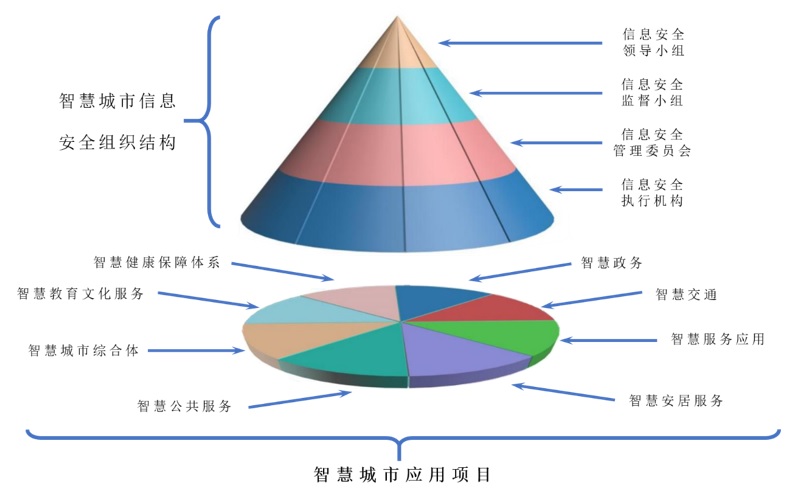 PDF(2070 KB)
PDF(2070 KB)


 PDF(2070 KB)
PDF(2070 KB)
 PDF(2070 KB)
PDF(2070 KB)
大数据环境下智慧城市信息安全保障体系构建研究
Research on the Construction of Smart City Information Security Assurance System under the Big Data Environment
[目的/意义] 大数据环境下智慧城市面临的信息安全问题日益突出,基于此构建大数据环境下全面感知、系统运作、协同整合的智慧城市信息安全保障体系,优化大数据环境下智慧城市信息安全管理,完善当下智慧城市信息安全建设具有一定的理论意义和实践价值。[方法/过程]将全面质量管理理论应用到智慧城市信息安全保障体系研究中,立足于信息安全的四项基本内涵,借助PDCA循环的4个阶段构建大数据环境下智慧城市信息安全保障体系基本架构。[结果/结论]通过PDCA循环解决智慧城市信息安全保障问题,符合城市建设和发展过程应不断动态调整的特点,为保障大数据环境下智慧城市信息安全的全过程实施提供参考,主要包括:规划阶段的“方向+目标、规范+约束、计划+指标”,实施阶段的组织结构、基础设施和技术体系,控制阶段的态势感知、应急响应和风险管理,改进阶段政府、运营方和公众的多主体协同。
[Purpose/significance] The information security problems faced by smart cities under the big data environment are becoming more and more prominent. Based on this, building an information security assurance system of smart cities with comprehensive perception, system operation and collaborative integration under the big data environment, optimizing information security management of smart cities under the big data environment and perfecting the current information security construction of smart cities have certain theoretical significance and practical value. [Method/process] Applying total quality management theory to the research of smart city information security assurance system, based on the four basic connotations of information security, this paper built the basic structure of smart city information security assurance system under the big data environment with the help of the four phases of the PDCA cycle. [Result/conclusion] This research solves the problem of smart city information security through the PDCA cycle, which is in line with the characteristics of continuous dynamic adjustments in the process of urban construction and development, and provides references for the entire process of ensuring smart city information security under the big data environment. It mainly includes: in the planning stage, "directions + goals, norms + constraints, plans + indicators"; in the implementation phase, the organizational structure, infrastructure and technical system; in the control phase, situational awareness, emergency response and risk management; and in the improvement phase , the multi-agent coordination of the government, operators and the public.

智慧城市 / 大数据 / 信息安全 / PDCA循环 / 保障体系
smart city / big data / information security / PDCA cycle / security system
| [1] |
沈明欢.“智慧城市”助力我国城市发展模式转型[J].城市观察,2010(3):140-146.
|
| [2] |
CHEN Z Y, FAN W, XIONG Z, et al.Visual data security and management for smart cities[J]. Frontiers of computer science in China,2010,4(3):386-393.
|
| [3] |
李勇.智慧城市建设对城市信息安全的强化与冲击分析[J].图书情报工作,2012,56(6):20-24.
|
| [4] |
邓贤峰.“智慧城市”建设的风险分析[J].财经界,2011(1):106-109.
|
| [5] |
ELMAGHRABY A S, LOSAVIO M M . Cyber security challenges in smart cities: safety, security and privacy[J]. Journal of advanced research, 2014, 5(4):491-497.
|
| [6] |
ZHANG K, NI J B, YANG K, et al. Security and privacy in smart city applications: challenges and solutions[J]. IEEE communications magazine, 2017, 55(1):122-129.
|
| [7] |
ALDAIRI A, TAWALBEH L. Cyber security attacks on smart cities and associated mobile technologies[J]. Procedia computer science, 2017, 109(3):1086-1091.
|
| [8] |
ABBAS H, MAGNUSSON C, YNGSTROM L, et al. Addressing dynamic issues in information security management[J]. Information management & computer security, 2011, 19(1):5-24.
|
| [9] |
芦效峰,李海俊.智慧城市的支撑技术——信息安全技术[J].智能建筑与城市信息,2013(2):90-98.
|
| [10] |
FERRAZ F S, FERRAZ C. Smart city security issues: depicting information security issues in the role of an urban environment[C]// IEEE /ACM 7th International Conference on Utility and Cloud Computing, London:IEEE, 2014: 842-847.
|
| [11] |
宋璟,李斌,班晓芳,等.关于我国智慧城市信息安全的现状与思考[J].中国信息安全, 2016(2):107-111.
|
| [12] |
向尚,邹凯,蒋知义,等.基于随机森林的智慧城市信息安全风险预测[J].中国管理科学,2016,24(S1):266-270.
|
| [13] |
QI L , HU C ,ZHANG X , et al. Privacy-aware data fusion and prediction with spatial-temporal context for smart city industrial environment[J]. IEEE transactions on industrial informatics, 2020, 17(6):1.
|
| [14] |
邹凯,向尚,张中青扬,等.智慧城市信息安全风险评估模型构建与实证研究[J].图书情报工作,2016,60(7):19-24.
|
| [15] |
毛子骏,梅宏,肖一鸣,等.基于贝叶斯网络的智慧城市信息安全风险评估研究[J].现代情报,2020,40(5):19-26,40.
|
| [16] |
毛子骏,黄膺旭,徐晓林.信息生态视角下智慧城市信息安全风险分析及应对策略研究[J].中国行政管理,2019(9):123-129.
|
| [17] |
张艳丰,王羽西,邹凯,等.基于模糊DANP的智慧城市信息安全风险要素识别与管理策略研究[J].情报理论与实践,2020,43(10):144-150.
|
| [18] |
邹凯,万震,曹丹,等.智慧城市信息安全监管策略的演化博弈分析[J].现代情报,2021,41(3):3-14.
|
| [19] |
李洋,谢晴,邱菁萍,等.智慧城市信息安全保障体系研究[J].信息技术与网络安全,2018,37(7):18-21.
|
| [20] |
张大江,毕晓宇,吕欣,等.智慧城市信息安全体系研究[J].信息安全研究,2017,3(8):710-717.
|
| [21] |
王青娥,柴玄玄,张譞.智慧城市信息安全风险及保障体系构建[J].科技进步与对策,2018,35(24):20-23.
|
| [22] |
杨天开,鲁洁.新型智慧城市环境下信息安全体系架构浅析[J].中国管理信息化,2019,22(19):140-142.
|
| [23] |
DAGHER G G , MOHLER J , MILOJKOVIC M , et al. Ancile: privacy-preserving framework for access control and interoperability of electronic health records using blockchain technology[J]. Sustainable cities & society, 2018,39(2):283-297.
|
| [24] |
MEMOS V A, PSANNIS K E, ISHIBASHI Y, et al. An efficient algorithm for media-based surveillance system (EAMSuS) in IoT smart city framework[J]. Future generation computer systems,2018,83(6):619-628
|
| [25] |
WAZID M, DAS A K, VIVEKANANDA B K , et al. LAM-CIoT: lightweight authentication mechanism in cloud-based IoT environment[J]. Journal of network and computer applications, 2020,150(1):102496
|
| [26] |
ULLAH Z, Al-TURJMAN F, MOSTARDA L, et al. Applications of artificial intelligence and machine learning in smart cities[J]. Computer communications, 2020, 154(3):313-323.
|
| [27] |
ZHANG K, NI J B, YANG K, et al. Security and privacy in smart city applications: challenges and solutions[J]. IEEE communications magazine: articles, news, and events of interest to communications engineers, 2017, 55 (1) :122-129.
|
| [28] |
王世伟.论大数据时代信息安全的新特点与新要求[J].图书情报工作,2016,60(6):5-14.
|
| [29] |
郭骅,苏新宁.智慧城市信息安全管理的环境、挑战与模式研究[J].图书情报工作,2016,60(19):49-58.
|
| [30] |
黄水清.数字图书馆信息安全管理的过程方法[J].图书情报工作,2013,57(11):5-11.
|
| [31] |
赵海,陈芳.电子支付信息安全管理体系的研究与实践[J].信息安全研究,2019,5(6):534-541.
|
| [32] |
刘珊,杨华,岳克明.大数据在电力信息安全的研究[J].山西电力,2018(4):45-47.
|
| [33] |
吴璇.PDCA在医院信息系统安全监管中的应用[J].网络安全技术与应用,2018(3):114-115.
|
| [34] |
曾剑秋,程广焕,杨萌柯.电信运营企业信息安全风险管理体系研究[J].科技管理研究,2016,36(18):160-164.
|
| [35] |
胡昌平,万莉.云环境下国家学术信息资源安全全面保障体系构建[J].情报杂志,2017,36(5):124-128.
|
| [36] |
高东怀,沈霞娟,宁玉文,等.高校信息化管理服务体系研究——以第四军医大学的实践为例[J].武汉大学学报(理学版),2012,58(S1):65-69.
|
| [37] |
胡鑫.智慧城市[J].电信技术,2016(9):46-47,51.
|
| [38] |
姜德峰, 齐瑞瑞.智慧城市基础设施建设与评估[J]. 电视技术, 2013(14):4-5.
|
| [39] |
范渊.大数据时代的智慧城市与信息安全[M].北京:电子工业出版社,2018:96.
|
| [40] |
王斌君,吉增瑞.信息安全技术体系研究[J].计算机应用,2009,29(S1):59-62.
|
| [41] |
GB/T 22240-2020,网络安全保护等级定级指南[S].北京,国家标准化管理委员会,2020.
|
| [42] |
王翔.网络与信息安全事件应急响应体系层次结构与联动研究[J].网络安全技术与应用,2015(5):177,179.
|
| [43] |
曾志廉,黄丹凤.信息安全风险评估综合管理系统设计[J].教育教学论坛,2016(23):249-250.
|
| [44] |
武彬,张玉清,毛剑.信息安全风险管理系统的设计与实现[J].计算机工程,2007(21):134-136,139.
|
| [45] |
官海滨,谢宗晓,王兴起.基于知识库的信息安全风险评估方法Crisk及其工具实现[J].青岛大学学报(自然科学版),2013,26(1):66-70.
|
| [46] |
王桢珍,谢永强,武晓悦,等.信息安全风险管理研究[J].信息安全与通信保密,2007(8):162-164,167.
|
邹凯: 提出研究思路,起草与修订论文;
郭一航: 设计研究框架,起草与修订论文;
向尚: 起草与修订论文;
万震: 收集相关文献,修订论文。
/
| 〈 |
|
〉 |